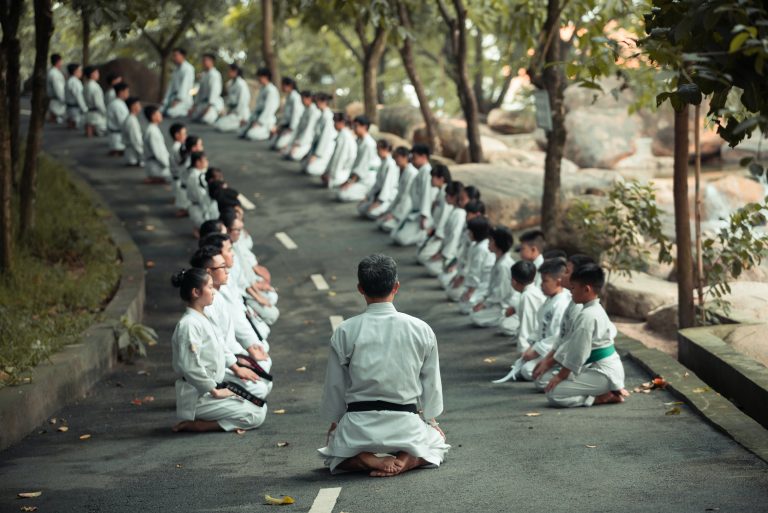Programm für ein Karate-Workout
Karate ist nicht nur ein Kampfsport, sondern auch eine effektive Aerobic-Übung, die den gesamten Körper trainieren kann. Ein gut geplantes Karate-Workout-Programm kann dazu beitragen, die allgemeine Gesundheit und Fitness zu verbessern und gleichzeitig die Technik und Fähigkeiten in diesem Kampfsport zu verbessern.
Eine kurze Einführung in Karate
Karate ist ein Kampfsport, der seinen Ursprung in Japan hat. Es handelt sich um einen Kampfsport, der es einem ermöglicht, die Techniken für den Angriff und die Verteidigung im Nahkampf zu erlernen. Die Techniken können auch für die Selbstverteidigung eingesetzt werden. Karate wird oft auch als eine Art Meditation betrachtet, da es auf den Prinzipien von Konzentration und Selbstbeherrschung basiert.
Warum ist Karate ein großartiges Workout?
Karate kann eine großartige Möglichkeit sein, den Körper kräftiger zu machen und den Geist zu schärfen. Es ist ein komplettes Cardio-Workout und kann dazu beitragen, den Stoffwechsel zu verbessern und die Herzgesundheit zu fördern. Darüber hinaus kann Karate dabei helfen, die Koordination und Flexibilität zu verbessern, während es Muskelkraft und Ausdauer aufbaut.
Ein Karate-Workout-Programm
Ein Karate-Workout-Programm kann je nach Fitness-Level und Zielsetzung individuell gestaltet werden. Es ist immer wichtig, auf eine angemessene Aufwärmphase zu achten. Einige mögliche Übungen für die Aufwärmphase sind leichtes Joggen, Wandern auf der Stelle, Kniebeugen oder Hampelmänner.
Im Folgenden sind einige Beispiele für ein Karate-Workout-Programm angeführt:
Programm 1 – Einsteiger
– 10 Minuten Aufwärmphase (leichtes Joggen, Hampelmänner, Kniebeugen).
– 10 Minuten Grundübungen (Grundtechniktraining wie Schläge, Tritte und Blöcke).
– 20 Minuten Kombinationstraining (Trainieren von Techniken in einer Abfolge).
– 10 Minuten Wurf- und Hebeltechniken (Training von Techniken, um den Gegner zu Fall zu bringen).
– 5 Minuten Cool-Down-Phase (Stretchen und Entspannen).
Programm 2 – Fortgeschrittene
– 10 Minuten Aufwärmphase (leichtes Joggen, Hampelmänner, Kniebeugen).
– 10 Minuten Grundübungen (Grundtechniktraining wie Schläge, Tritte und Blöcke).
– 30 Minuten Kombinationstraining (Trainieren von Techniken in einer Abfolge).
– 15 Minuten Kata (Training von festgelegten Bewegungsabläufen).
– 10 Minuten Kumite (Kampftraining).
– 5 Minuten Cool-Down-Phase (Stretchen und Entspannen).
Die Vorteile eines hochintensiven Karate-Workouts
Wenn man ein hochintensives Karate-Workout durchführt, kann man ein großes Kaloriendefizit erzielen und somit Gewicht verlieren. Das Training kann auch dazu beitragen, das Durchhaltevermögen zu steigern und das Selbstbewusstsein zu stärken.
Fazit
Karate ist ein großartiger Kampfsport, der auch als Aerobic-Übung genutzt werden kann. Durch ein entsprechendes Workout-Programm können die körperliche Fitness, die Koordination, die Flexibilität und die Muskelkraft verbessert werden. Die Wahl eines geeigneten Karate-Workout-Programms hängt von den jeweiligen individuellen Zielen und dem Fitnesslevel ab.
Frequently Asked Questions About a Karate Workout Program
Are you looking for a good karate workout program? If yes, you’re in the right place. Here are some frequently asked questions about karate workouts and program options.
1. What are the benefits of karate workouts?
Karate workouts are beneficial to both physical and mental health as they promote total body fitness. Incorporating karate into your workout regimen can help you develop body strength, flexibility, agility, and balance. Besides, karate workouts are excellent for cardiovascular fitness. Practicing karate regularly will also help promote mental health and relieve stress.
2. Can anyone learn karate?
Yes, anyone can learn karate, regardless of age or gender. Karate is a sport for people of all ages and abilities, and there’s always a baseline level for everyone to start. Based on your current fitness level, you can customize your workout program. It’s always essential to have a qualified instructor to guide you in learning the proper techniques and prevent injuries.
3. What are the basic karate moves?
The basic karate moves include punches, kicks, and blocks, which are executed with either the arms or legs. To master these moves, you need to engage in regular practice and gradually increase the complexity of your movements. Your instructor should help you identify your weak points and work with you to improve your skills.
4. How long does it take to master karate?
The amount of time it takes to master karate depends on individual effort and dedication. However, the general consensus is that it takes about three years of consistent training to reach the black belt level. Keep in mind that karate is more than just physical practice. It also requires mental focus and discipline.
5. How often should I practice karate workouts?
For optimal progress, you should practice karate workouts at least three times a week. This frequency ensures that your body can adapt to the new movements and techniques. Additionally, it’s crucial to give your body rest and recovery time after each workout. Overtraining can cause injuries or burnout, which can negatively impact your progress.
6. What equipment do I need for karate workouts?
To begin your journey with karate, you don’t need much equipment. Some essentials you should have include:
- Karate uniform (gi)
- Belt
- Karate shoes or bare feet
As you progress, there may be additional tools required such as punching bags, mitts, or sparring gear.
7. How do I find a good karate instructor?
Finding a good karate instructor is crucial, as they will guide you in your karate training, and their expertise has a great impact on your progress. It’s essential to look for an instructor who has several years of experience, a good reputation in the community, and the appropriate licensing or certification.
8. Are there specific styles of karate?
Yes, there are many styles of karate, and each has its unique approach to training and techniques. Some of the most popular karate styles include Shotokan, Goju-Ryu, Wado-Ryu, and Shito-Ryu. Before joining a karate program, it’s essential to research different styles and find the one that aligns with your goals, preferences, and fitness level.
9. Can karate workouts help with self-defense?
Yes, karate workouts can equip you with self-defense skills that are valuable in real-life scenarios. During your training, you’ll learn basic self-defense techniques such as blocking, striking, and escaping from various positions. However, karate is more than just knowing how to fight. It also teaches self-discipline, awareness of one’s surroundings, and mental focus.
10. How can I incorporate karate into my fitness routine?
You can incorporate karate workouts into your fitness routine by attending regular classes, practicing at home, or combining it with other fitness activities such as yoga, strength training, or cardio sessions. To ensure optimal progress, you should consult with your instructor and develop a custom workout program that aligns with your goals.
Conclusion
Karate is a popular sport and a great way to incorporate a holistic approach to health and fitness. However, starting karate can be intimidating. With the answers to these frequently asked questions, we hope you are better informed and more confident about beginning your karate journey. Remember, the key to success in karate is consistency, discipline, and dedication.
Inhaltsverzeichnis






